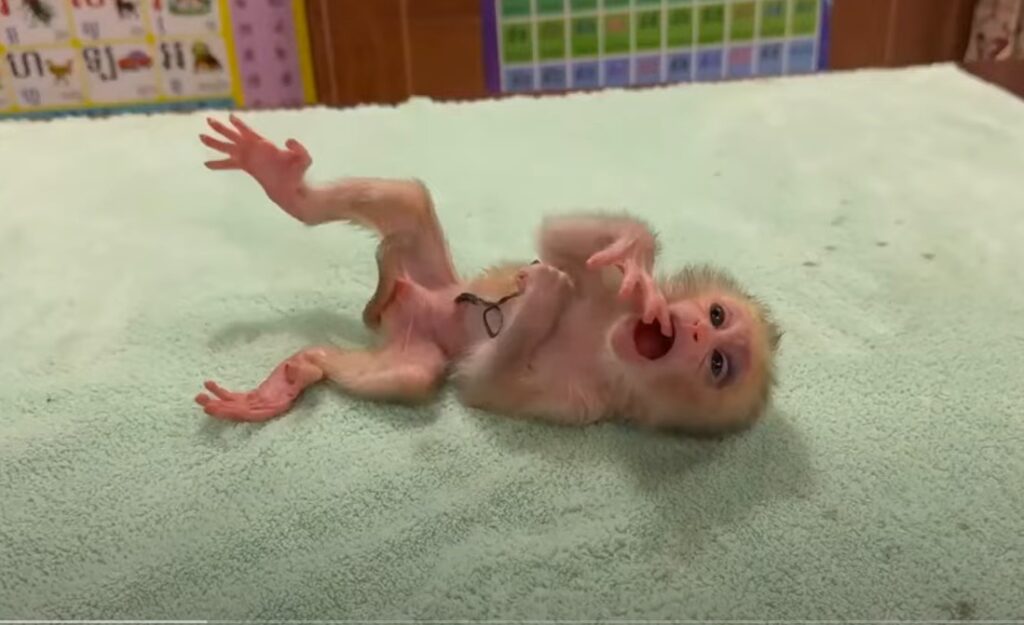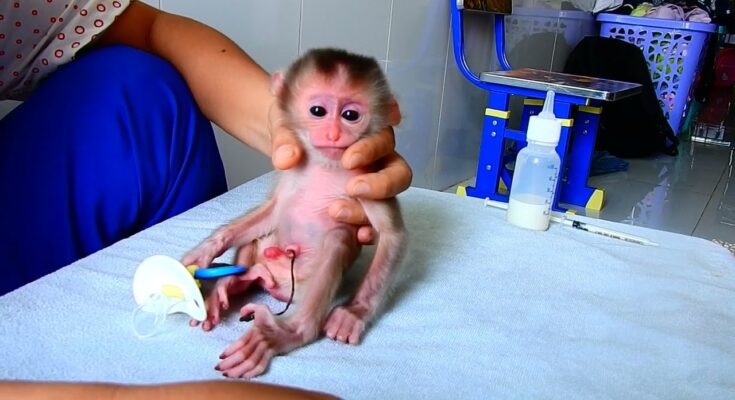In the dense rainforests of Southeast Asia, where the sun barely penetrates through the thick canopy of trees, a heartbreaking story unfolds. A newborn monkey, barely a few days old, clings to the frail body of its mother as she struggles to protect it from the harsh realities of the jungle. Their lives are fragile—especially for the poor baby monkey, who faces the peril of being abandoned, hungry, and exposed to the unforgiving world around it.

This little monkey, likely a species of macaque, gibbon, or langur, was born into an environment where survival is not guaranteed. Baby monkeys rely on their mothers for warmth, nourishment, and protection, but in the wild, threats abound. From the moment it takes its first breath, this tiny creature is faced with the daunting challenges of life. Without a mother who can protect it or provide for its needs, a baby monkey’s chances of survival decrease drastically.
Sadly, this scenario is becoming all too common. Habitat loss due to deforestation, hunting, and the encroachment of human settlements into wildlife territories have pushed these animals into vulnerable conditions. The newborn monkey may have been separated from its mother, either because of poachers or due to the ever-shrinking green spaces where monkeys once thrived in abundance. Some species, like the critically endangered Hainan Gibbon or the endangered Macaque, are already teetering on the brink of extinction. A baby born into such circumstances is not just a newborn; it’s a symbol of the fragility of biodiversity in a world where human activities often dominate.
In the early days of life, a baby monkey is completely dependent on its mother. It clings to her fur, drinking the milk that will nourish its frail body and provide the energy it needs to grow. Without this nourishment, its survival is in question. The poor baby monkey in this story is malnourished, weakened by the absence of its mother’s care. Its fragile body is shivering, struggling to find the warmth and comfort that it so desperately needs. The wild world offers no compassion for the weak, and predators—ranging from large birds of prey to carnivorous mammals—are always lurking, ready to take advantage of a vulnerable creature.
For those who are fortunate enough to encounter such a situation, the heartache is palpable. Conservationists, animal rescue organizations, and wildlife experts often rush in to save orphaned or abandoned monkeys. But the journey of rescuing a newborn monkey is not without its challenges. Finding a baby monkey in the wild is only the first hurdle. The rescue team must then provide medical attention to ensure it survives the trauma of being separated from its mother and the elements of the jungle. Once saved, the baby may require feeding, hydration, and a safe, warm environment to regain its strength.
But even with all the best efforts, the long-term outcome is uncertain. In some cases, the rescued baby is placed into wildlife sanctuaries or rehabilitation centers where it can grow in a safe environment. There, it may learn the necessary skills to survive in the wild once it’s old enough. However, the bond between mother and child is irreplaceable, and the process of rehabilitation can take time. Without a family unit, the baby monkey faces emotional and social challenges, just as a human child would. The rehabilitation process is a complex and delicate journey, one that requires specialized care and a deep understanding of animal behavior.
The plight of newborn monkeys, particularly those born into poor conditions, highlights a broader issue: the fragile state of wildlife around the world. Many species of monkeys are now facing extinction, not because of any fault of their own, but because of the destruction of their natural habitat, the illegal wildlife trade, and the rapid pace of environmental change. Their plight is a reminder that the survival of many animal species is intertwined with our own actions.
We must act before it’s too late. Conservation efforts are critical, and every small action—from donating to wildlife organizations to supporting sustainable practices—can help ensure a future for these vulnerable creatures. The newborn poor baby monkey is more than just an individual. It represents the countless animals around the world struggling to survive in an increasingly hostile environment. In the end, the fate of these animals rests in our hands. Let’s hope that we, as a society, can learn to protect the natural world and ensure that future generations of monkeys—and all creatures—have a fighting chance at life.



